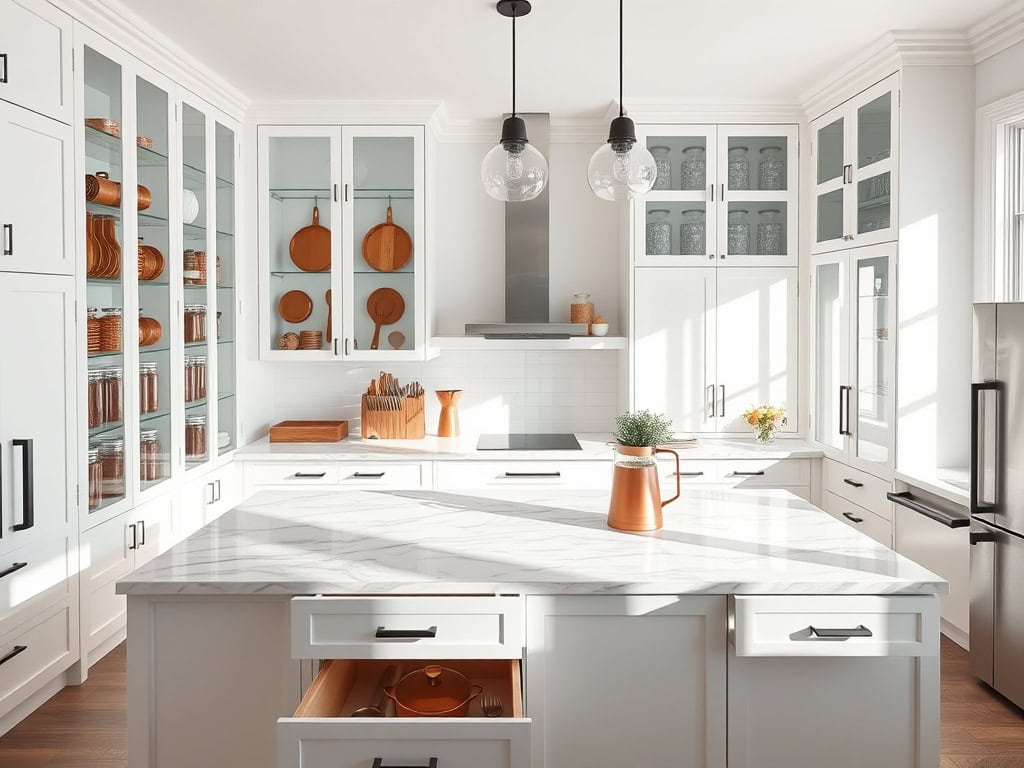Is your kitchen giving you a bit of a headache lately? I’ve been there – watching cooking supplies multiply while cabinet space seems to shrink! As a home organization enthusiast who’s transformed countless chaotic kitchens, I’m excited to share nine game-changing solutions that’ll help you reclaim your countertops and create a space that’s both functional and Instagram-worthy. From tech-savvy pantry systems to clever vertical storage hacks, these modern ideas will revolutionize how you think about kitchen organization.
Vertical Storage Solutions: Making the Most of Wall Space
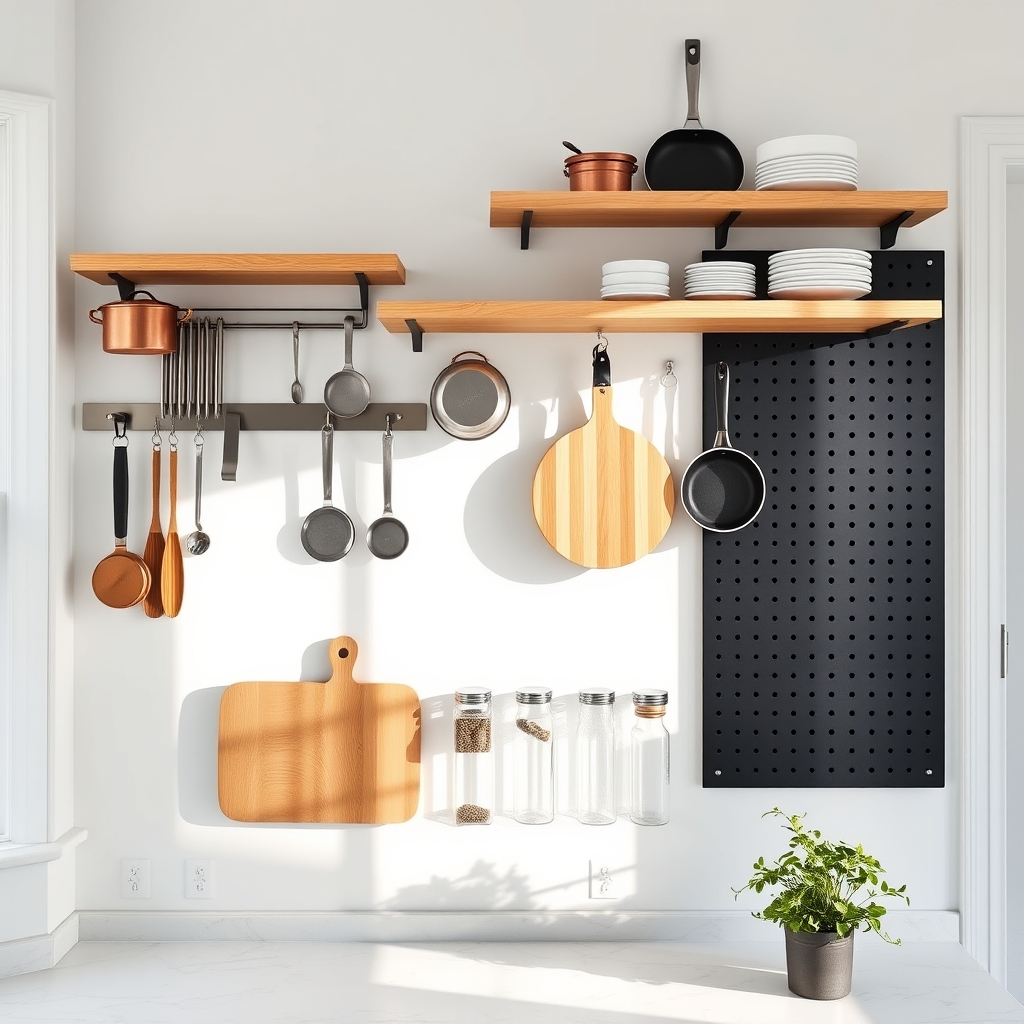
Making the most of wall space is a game-changer in kitchen organization, particularly in smaller kitchens where counter space is limited. Vertical storage transforms unused wall areas into functional storage zones, creating additional space for cookware, utensils, and frequently used items while keeping them easily accessible.
By utilizing vertical space effectively, you can free up valuable counter and cabinet space while creating a more organized and visually appealing kitchen environment. Well-planned vertical storage solutions can reduce clutter, improve workflow, and make cooking more efficient by keeping essential items within arm’s reach.
Required Items:
- Wall-mounted shelving units
- Pegboards and hooks
- Magnetic knife strips
- Wall-mounted spice racks
- Heavy-duty mounting hardware
- Level
- Drill and drill bits
- Stud finder
- Measuring tape
- Pencil
- Anchors and screws
Start by conducting a thorough assessment of your available wall space, paying special attention to areas above countertops, beside cabinets, and any unused wall sections. Use a stud finder to locate stable mounting points and mark them clearly.
Install your chosen storage solutions starting with larger items like shelving units, ensuring they’re level and securely anchored. Mount magnetic strips at eye level for easy knife access, and position pegboards where they’ll be most convenient for hanging frequently used items.
Position frequently used items at eye level and within easy reach of your primary work zones. Store heavier items on lower shelves and lighter items higher up. Group similar items together and consider using clear containers or labels to maintain organization.
When installing pegboards, create a layout plan first to ensure efficient use of space and proper tool placement.
Additional Tips: Consider incorporating adjustable solutions that can be modified as your storage needs change. Use vertical space near the cooking zone for spices and cooking utensils, and place less frequently used items in higher spaces.
Install adequate lighting to ensure all stored items are visible and accessible. Regular maintenance of mounting hardware will ensure long-term safety and stability of your vertical storage system.
Smart Cabinet Organization Systems
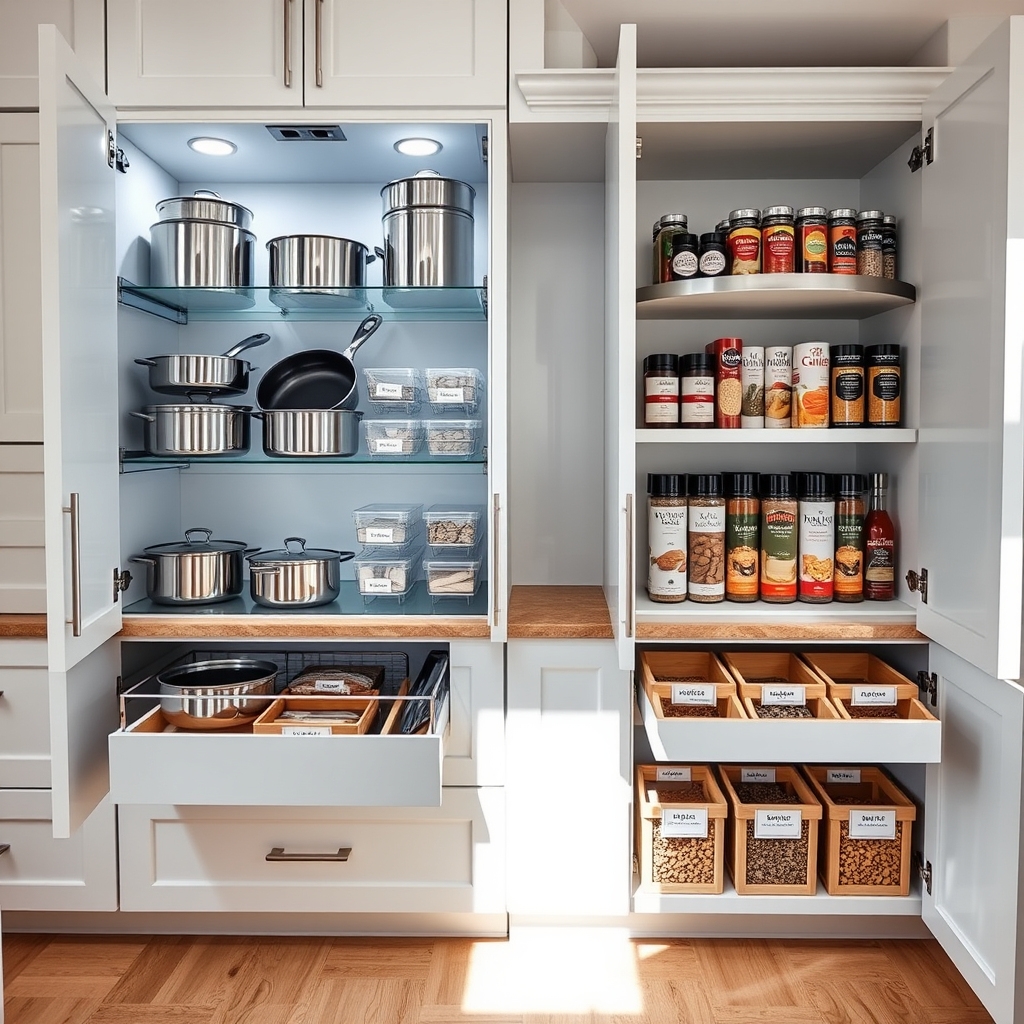
An organized cabinet system serves as the foundation of a well-functioning kitchen, transforming cluttered chaos into an efficient workspace. Properly organized cabinets not only save valuable time during meal preparation but also maximize storage space and help maintain the longevity of kitchen items by preventing damage from overcrowding or improper storage.
Smart cabinet organization systems eliminate the frustration of searching for items and create a logical flow in your kitchen workspace. By implementing proper organizational solutions, you can increase storage capacity by up to 50% while ensuring frequently used items remain easily accessible and visible at all times.
Required Items:
- Cabinet organizers (pull-out drawers, lazy Susans)
- Clear storage containers
- Shelf risers
- Label maker
- Measuring tape
- Cabinet door organizers
- Drawer dividers
- Under-shelf baskets
- Command hooks
- Non-slip liner
Start by completely emptying your cabinets and grouping similar items together. Measure each cabinet’s dimensions and map out zones based on usage frequency and logical workflow. Install pull-out drawers in deep cabinets to maximize accessibility, and position lazy Susans in corner cabinets to utilize otherwise difficult-to-reach spaces.
Use shelf risers to create vertical storage solutions, effectively doubling the usable space in each cabinet. For upper cabinets, arrange items by frequency of use, with everyday items at eye level and occasional-use items stored higher up. Implement clear storage containers for dry goods, ensuring they’re properly labeled and easily visible.
Install door-mounted organizers for flat items like cutting boards and baking sheets. Configure lower cabinets with drawer dividers for pots, pans, and lids, using vertical organizers to prevent stacking and scratching.
Additional Tips: Regularly review and adjust your organization system every three months to ensure it continues meeting your needs. Remove rarely used items to prevent overcrowding, and maintain zones by immediately returning items to their designated spots after use.
Consider installing motion-sensor cabinet lights to improve visibility and accessibility, particularly in deep or corner cabinets.
Hidden Countertop Storage Solutions
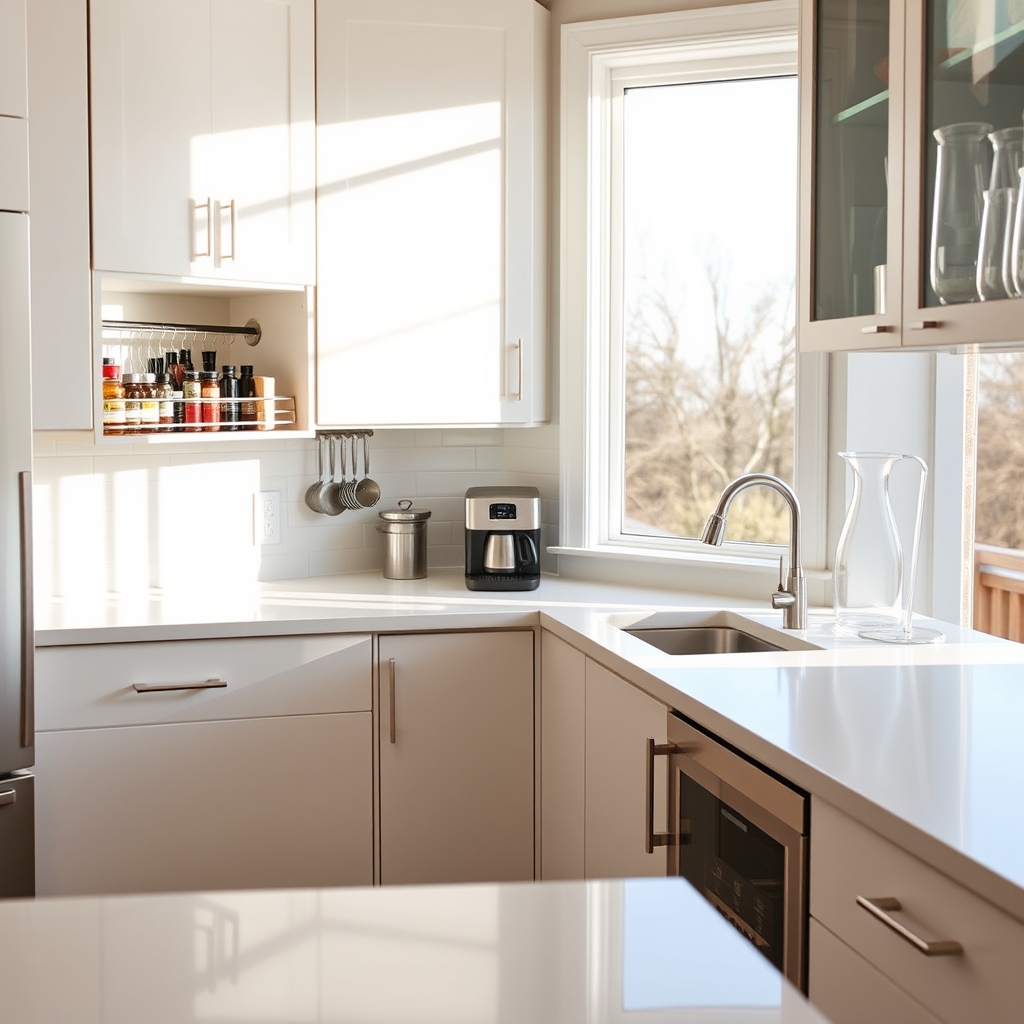
Maximizing countertop space is crucial for maintaining an efficient and functional kitchen. When surfaces are cluttered with appliances, utensils, and cooking essentials, it becomes challenging to prepare meals and maintain a clean, organized workspace.
Hidden countertop storage solutions offer innovative ways to keep necessary items within reach while preserving valuable counter space. Strategic concealment of everyday items not only creates a more aesthetically pleasing kitchen but also protects items from dust, grease, and other kitchen elements.
By implementing hidden storage solutions, you can transform your countertops from chaotic catch-alls into streamlined work surfaces that enhance both functionality and visual appeal.
Required Items:
- Under-cabinet mounting brackets
- Pull-down storage racks
- Magnetic strips
- Corner shelf organizers
- Cabinet door organizers
- Tension rods
- Command hooks
- Clear storage containers
- Labels
- Measuring tape
- Screwdriver
- Level
Begin by assessing your countertop items and categorizing them based on frequency of use. Install under-cabinet mounting brackets to create pull-down storage for frequently used items like paper towels or cooking utensils.
Utilize the inside of cabinet doors by mounting organizational racks or holders for items such as cutting boards, pot lids, or spice containers. For corner spaces, install rotating organizers or lazy Susans to maximize otherwise difficult-to-reach areas.
Create vertical storage solutions by mounting magnetic strips under cabinets for metal utensils or installing tension rods to hang spray bottles. Use clear storage containers with labels for items that must remain on the counter, such as cooking oils or frequently used dry goods, and arrange them in designated zones based on their purpose in food preparation.
Additional Tips:
Maintain your hidden storage systems by regularly reviewing and adjusting the organization as needed. Consider implementing a “one-in-one-out” rule when adding new kitchen items, and periodically assess whether stored items are still necessary or frequently used.
Clean and check mounting hardware every few months to ensure everything remains secure and functional.
Tech-Integrated Pantry Management

Modern pantry management has evolved beyond simple shelving and containers. Integrating technology into pantry organization revolutionizes how we track, store, and utilize our food items, reducing waste and streamlining grocery shopping. A tech-integrated pantry system can alert you about expiration dates, automatically generate shopping lists, and help maintain optimal inventory levels.
Smart pantry management combines traditional organizational methods with digital solutions, creating a seamless system that works for busy households. This integration allows family members to check pantry contents remotely, scan items as they’re used, and maintain a real-time inventory that can be accessed from any connected device.
Required Items:
- Smartphone or tablet
- Inventory management app
- Smart labels or barcode scanner
- Wi-Fi connection
- Digital food scale
- Smart storage containers
- Label maker
- Shelf organizers
- Clear containers
- Battery-powered shelf lights
Start by emptying your pantry and categorizing items while downloading your chosen inventory management app. Install smart labels or QR codes on shelves and containers, linking them to your digital system. As you return items to the pantry, scan each product into your app, inputting expiration dates and quantity information.
Arrange items by category, placing frequently used products at eye level and ensuring all smart labels are easily scannable. Configure your app’s settings to send notifications for low inventory and approaching expiration dates. Create zones within your pantry that correspond to your digital categories, making it easier to maintain the system.
Connect your smart containers to the network and sync them with your management app, allowing them to track contents and weight automatically. For optimal results, perform weekly system checks to ensure all technology is functioning correctly. Establish a family protocol for scanning items in and out of the pantry, and regularly back up your inventory data.
Consider connecting your smart pantry system to your preferred grocery delivery service for automated reordering of staple items when supplies run low.
Multi-Functional Kitchen Island Storage
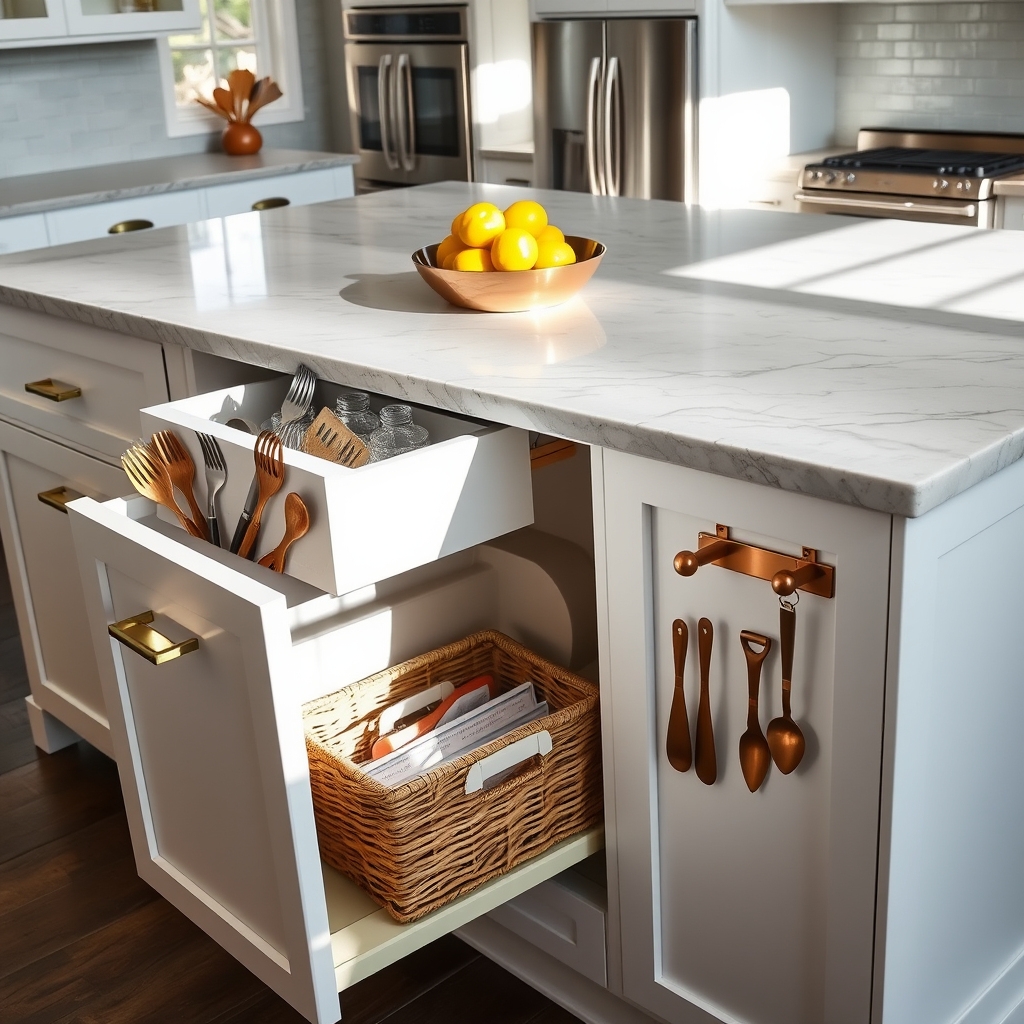
A well-organized kitchen island serves as the heart of any kitchen, offering valuable storage space while functioning as a preparation area, dining spot, and gathering place. When properly organized, it can dramatically increase kitchen efficiency by keeping essential items within arm’s reach and maximizing available space in an often-crowded kitchen environment.
Strategic organization of kitchen island storage can transform a cluttered workspace into a streamlined cooking and entertaining zone. By implementing smart storage solutions and maintaining designated areas for specific items, you can enhance workflow, reduce cleanup time, and create a more enjoyable cooking experience.
Required Items:
- Drawer organizers
- Cabinet shelf risers
- Pull-out baskets
- Clear storage containers
- Label maker
- Drawer liners
- Hooks
- Tension rods
- Magnetic strips
- Under-counter mounting hardware
Start by emptying all island storage spaces and sorting items into categories based on frequency of use and function. Install drawer organizers to separate utensils, cooking tools, and small appliances.
Utilize vertical space by adding shelf risers in cabinets and installing hooks or magnetic strips on the sides of the island for frequently used items. Place everyday cooking essentials in easily accessible drawers, while storing lesser-used items in lower cabinets.
For deeper cabinets, install pull-out baskets or sliding organizers to maximize corner spaces and prevent items from getting lost in the back. Dedicate specific zones based on activity – create a baking station in one section, a meal prep area in another, and perhaps a beverage station if space allows.
Use clear containers to store dry goods and cooking ingredients, ensuring all items are visible and easily accessible.
Additional Tips: Consider implementing a rotating organization system where items are periodically evaluated for usefulness and relocated based on seasonal needs or changing cooking habits.
Keep a small notepad in one of the drawers to track items that need restocking, and regularly clean and maintain organizers to prevent dust and debris accumulation. This proactive approach will help maintain the organization system long-term.
Custom Drawer Organizers and Dividers
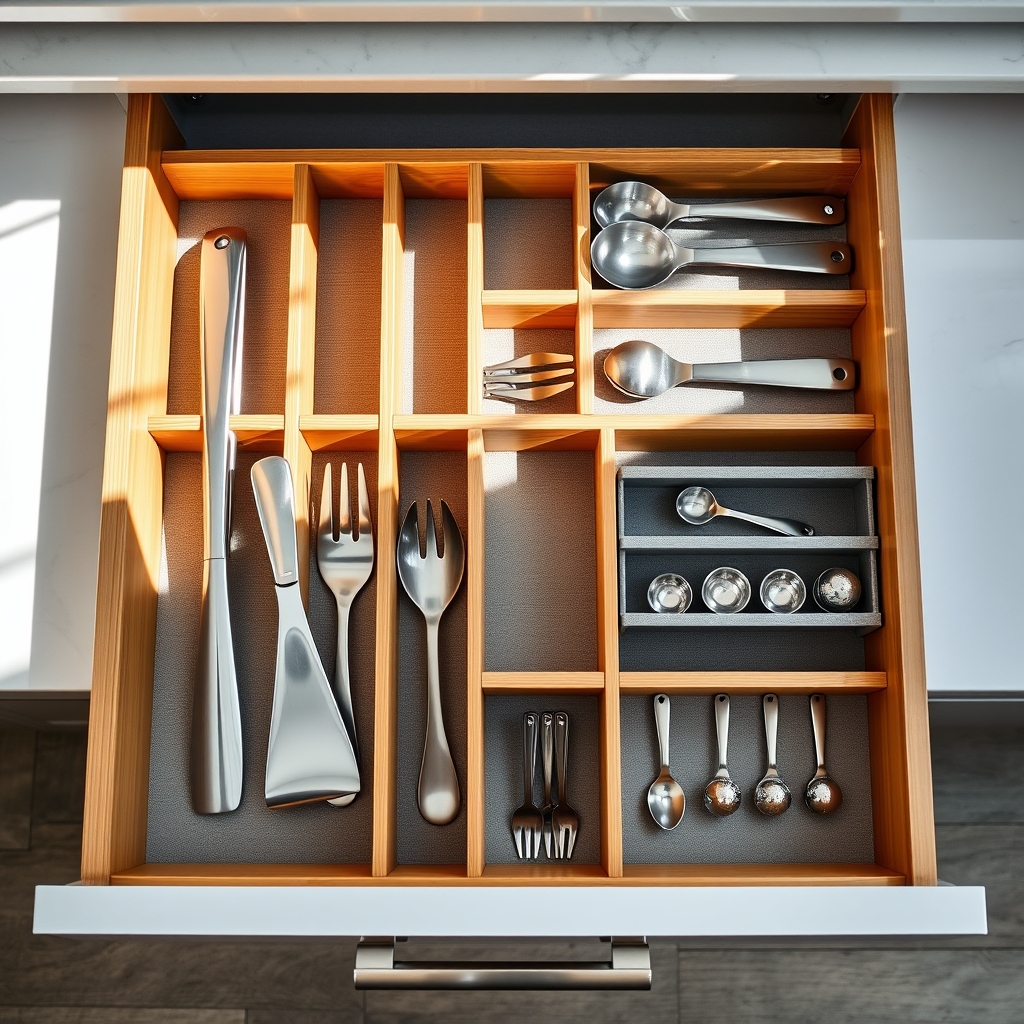
Well-organized kitchen drawers are fundamental to a functional kitchen, serving as designated homes for everything from utensils to gadgets. When drawers are properly compartmentalized, you eliminate the frustration of rummaging through jumbled items and save valuable time during meal preparation and cooking.
Custom drawer organizers and dividers take organization to the next level by creating tailored spaces that perfectly fit your specific items and drawer dimensions. Unlike one-size-fits-all solutions, custom organizers maximize every inch of drawer space while keeping items secure and easily accessible.
Required Items:
- Measuring tape
- Pencil and paper
- Custom drawer dividers
- Non-slip drawer liner
- Double-sided tape
- Scissors
- Clear adhesive labels
- Adjustable drawer organizers
- Wood or bamboo divider inserts
- Drawer depth stops (optional)
Start by removing everything from the drawer and measuring its interior dimensions, including depth. Group similar items together and measure the space needed for each category. Sketch a layout plan that accounts for item sizes and frequency of use, placing frequently used items toward the front.
Install non-slip liner at the bottom of the drawer to prevent shifting. For custom organization, combine different types of dividers to create the perfect configuration. Use adjustable dividers for flexibility, and fixed compartments for items that maintain consistent groupings. Secure dividers firmly in place using the appropriate mounting method for your chosen organizers.
Consider implementing a tiered system for deeper drawers to maximize vertical space.
Additional Tips: Review and adjust your drawer organization system after a few weeks of use. Some initial configurations may need tweaking based on daily patterns. Label compartments clearly to maintain organization, and consider using clear dividers to easily spot items.
Remember to leave about 10% extra space in each compartment to accommodate new items and make retrieval easier.
Minimalist Open Shelving Strategies
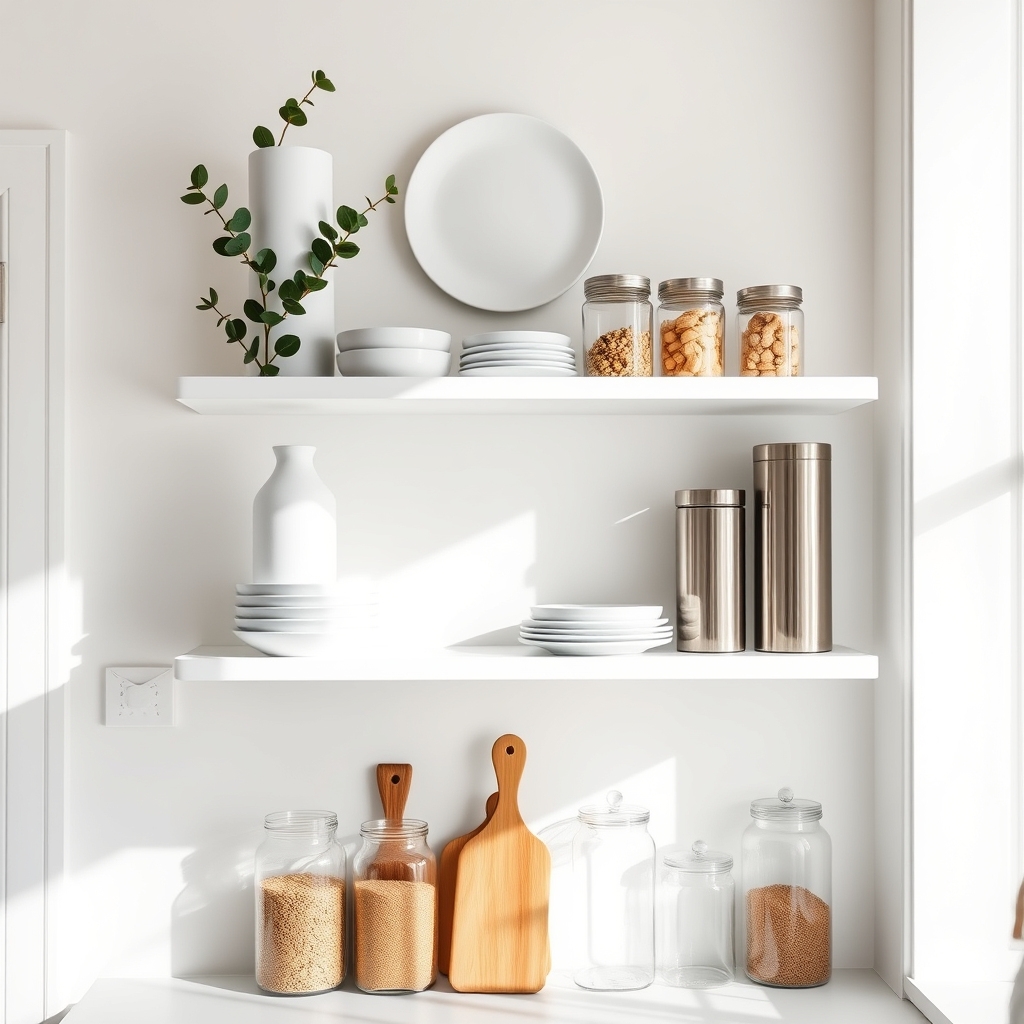
Open shelving has become a cornerstone of modern kitchen design, offering both aesthetic appeal and practical functionality. When properly organized, these exposed storage spaces create an airy, spacious feeling while keeping everyday items within easy reach. The key to successful open shelving lies in striking the perfect balance between practicality and visual appeal.
A minimalist approach to open shelving not only creates a clean, uncluttered look but also encourages mindful purchasing habits and helps maintain organization long-term. By displaying only essential items and maintaining a cohesive color scheme, open shelves can become a striking design element rather than a source of visual chaos.
Required Items:
- Matching storage containers
- Glass jars of various sizes
- Shelf liner or contact paper
- Label maker or labels
- Decorative baskets or bins
- Shelf risers
- Measuring tape
- Cleaning supplies
- Container lid organizers
- Shelf dividers
Start by removing everything from your shelves and thoroughly cleaning the surfaces. Group items by category and frequency of use, keeping only what you genuinely need and use regularly. Arrange everyday items at eye level, with less frequently used items on higher shelves.
Transfer dry goods into matching containers, ensuring all labels face forward for easy identification. Create visual harmony by maintaining consistent spacing between items and establishing a color scheme. Place heavier items on lower shelves for stability and safety.
Incorporate decorative elements sparingly, using them as functional pieces when possible – such as a beautiful pitcher for utensil storage or artisanal bowls for fruit display. To maintain your minimalist open shelving system, implement a regular cleaning schedule and periodic reorganization.
Keep backup supplies in closed storage elsewhere, rotating items as needed. Consider the rule of thirds when styling shelves, and maintain negative space to prevent visual overwhelm. Remember that successful minimalist shelving requires ongoing editing – if you add something new, consider removing something else to maintain balance.
Corner Space Optimization Techniques

Corner spaces in kitchens often become dead zones where items disappear into a black hole of inaccessibility. These awkward angles can waste valuable storage real estate in a room where every inch counts. When properly organized, corner spaces can transform from problematic areas into highly functional storage solutions that maximize your kitchen’s potential.
Optimizing corner spaces requires a strategic approach that considers both accessibility and visibility. The right combination of storage solutions and organizational methods can turn these traditionally challenging areas into some of your kitchen’s most valuable storage spots, making frequently used items easily reachable while maximizing the deep space for less-used items.
Required Items:
- Lazy Susan (single or double-tier)
- Corner drawer organizers
- Pull-out corner cabinet systems
- Clear storage containers
- Shelf risers
- Measuring tape
- Labels
- Cabinet door mounted organizers
- LED strip lights (optional)
- Corner brackets
Start by completely emptying the corner space and measuring all dimensions, including depth and height. Install your chosen corner organization system, whether it’s a Lazy Susan, pull-out mechanism, or tiered shelving.
For upper corner cabinets, arrange items by frequency of use, with daily items at eye level and seasonal items higher up. In lower corner cabinets, implement a pull-out system or Lazy Susan, organizing items by category, such as pots and pans, or baking supplies.
Place frequently used items toward the front of the space or on the outer edge of rotating systems. Group similar items together and use clear containers to keep smaller items organized and visible.
When utilizing drawer systems in corner spaces, implement diagonal dividers to maximize the angular space and prevent items from sliding during drawer operation.
For enhanced organization success, maintain clear zones by establishing specific homes for items and labeling spaces accordingly. Consider installing under-cabinet lighting to illuminate dark corners, making items easier to locate.
Regularly review and adjust your organization system based on usage patterns, and avoid overcrowding corners by maintaining a 20% empty space buffer for easy access and future additions.
Sustainable Kitchen Storage Solutions
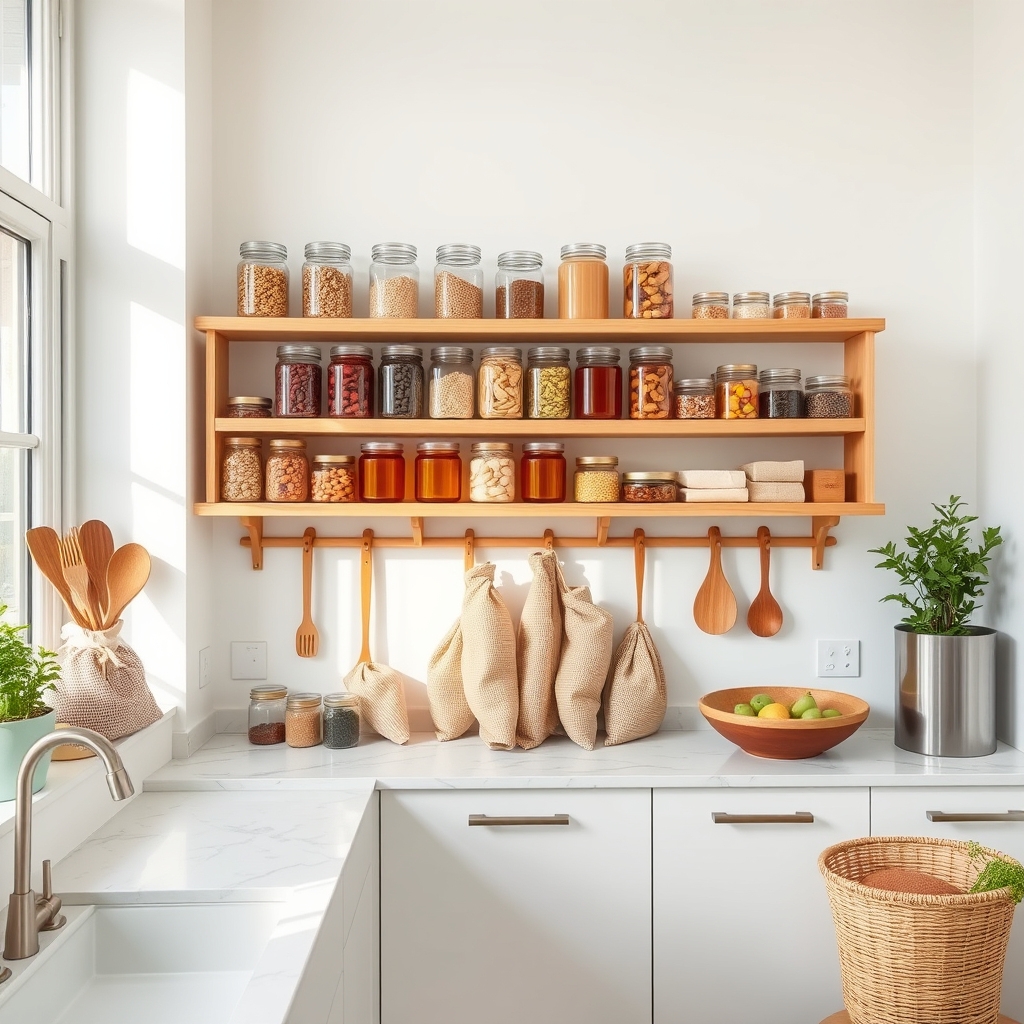
Creating a sustainable kitchen storage system is more than just tidying up – it’s about establishing an eco-conscious approach to organizing your cooking space while reducing waste and environmental impact. A well-planned sustainable storage solution helps minimize food waste, reduces reliance on single-use plastics, and creates a more efficient cooking environment.
Sustainable kitchen organization transforms how we interact with our food and cooking supplies while promoting environmentally responsible habits. By implementing reusable containers, natural materials, and waste-reducing systems, you’ll not only create a more organized space but also contribute to a healthier planet.
Required Items:
- Glass storage containers
- Mason jars
- Bamboo or wooden organizers
- Cotton produce bags
- Beeswax wraps
- Labels and markers
- Compost bin
- Bulk storage containers
- Natural fiber baskets
- Reusable silicone bags
Begin by decluttering your kitchen and removing all single-use plastic containers and packaging. Replace these with glass jars and containers, organizing them by size and function. Create designated zones for bulk ingredients, using clear containers with airtight seals to maintain freshness and visibility.
Install a proper composting system under the sink or in a convenient location to manage food waste effectively. Group similar items together using sustainable organizers made from bamboo or other renewable materials. Implement a FIFO (First In, First Out) system for perishables to minimize food waste.
Convert drawer and cabinet storage to accommodate reusable produce bags, beeswax wraps, and silicone storage solutions. Label everything clearly to maintain organization and prevent unnecessary purchases.
Additional Tips: Regularly audit your storage systems to identify areas for improvement and further reduction of waste. Consider vertical storage solutions to maximize space efficiency, and rotate seasonal items to maintain organization. Keep a running inventory of pantry items to prevent overbuying and ensure you’re using all available resources effectively.
Remember that sustainable organization is an ongoing process that may require periodic adjustments to meet your changing needs.

